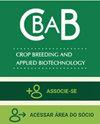Recurrent selection in papaya: An effective strategy for the continuous development of new cultivars
IF 1.1
4区 农林科学
Q2 Agricultural and Biological Sciences
引用次数: 1
Abstract
Abstract: Part of the success of a breeding program depends on the composition of the base population. Superior genotypes and unimproved dioecious varieties are sources of genes for traits of interest and excellent options for the formation of segregating populations. Here we describe the first cycle of recurrent selection (RS) in papaya and propose an effective strategy, unprecedented in the crop, to generate variability and new cultivars. Initially, the RS base population (UCP-C0) was developed with wide variability. Subsequently, 196 S1 progenies were obtained, evaluated in a trial, and the superior 40 S1 progenies were recombined. Among the traits of the selected progenies, high fruit yield (producing two to five fruits per axil) stands out. The S1 progenies were recombined and their seed bulk corresponds to the base population for the second cycle (UCP-C1). The results of the first cycle demonstrate the genetic potential of this population for the development of superior cultivars, and the breeding strategy applied is promising.番木瓜的重复选择:新品种持续发展的有效策略
摘要:育种计划的成功部分取决于基础种群的组成。优良基因型和未改良的雌雄异株品种是感兴趣性状的基因来源,也是形成分离群体的绝佳选择。在这里,我们描述了番木瓜的第一个循环重复选择(RS),并提出了一种有效的策略,这在作物中是前所未有的,以产生变异性和新品种。最初,RS基本群体(UCP-C0)是在具有广泛变异性的情况下发展起来的。随后,获得196个S1子代,在试验中进行评估,并重组优势的40个S1子后代。在所选后代的性状中,高产(每个叶腋产两到五个果实)尤为突出。S1子代被重组,并且它们的种子体积对应于第二个周期(UCP-C1)的基本群体。第一个周期的结果证明了该群体在培育优良品种方面的遗传潜力,所采用的育种策略是有前景的。
本文章由计算机程序翻译,如有差异,请以英文原文为准。
求助全文
约1分钟内获得全文
求助全文
来源期刊
CiteScore
2.40
自引率
13.30%
发文量
25
审稿时长
6-12 weeks
期刊介绍:
The CBAB – CROP BREEDING AND APPLIED BIOTECHNOLOGY (ISSN 1984-7033) – is the official quarterly journal of the Brazilian Society of Plant Breeding, abbreviated CROP BREED APPL BIOTECHNOL.
It publishes original scientific articles, which contribute to the scientific and technological development of plant breeding and agriculture. Articles should be to do with basic and applied research on improvement of perennial and annual plants, within the fields of genetics, conservation of germplasm, biotechnology, genomics, cytogenetics, experimental statistics, seeds, food quality, biotic and abiotic stress, and correlated areas. The article must be unpublished. Simultaneous submitting to another periodical is ruled out. Authors are held solely responsible for the opinions and ideas expressed, which do not necessarily reflect the view of the Editorial board. However, the Editorial board reserves the right to suggest or ask for any modifications required. The journal adopts the Ithenticate software for identification of plagiarism. Complete or partial reproduction of articles is permitted, provided the source is cited. All content of the journal, except where identified, is licensed under a Creative Commons attribution-type BY. All articles are published free of charge. This is an open access journal.

 求助内容:
求助内容: 应助结果提醒方式:
应助结果提醒方式:


